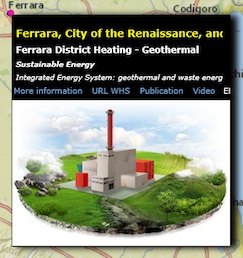Integrated Energy System: geothermal and waste energy sources.
 Ferrara is situated in the north of Italy. It covers an area of 404 km2 with a population of 134,000. The town was listed as a Unesco world heritage in 1995. The land is flat and the town centre closed in by ramparts is a good example of the Italian Renaissance.
Ferrara is situated in the north of Italy. It covers an area of 404 km2 with a population of 134,000. The town was listed as a Unesco world heritage in 1995. The land is flat and the town centre closed in by ramparts is a good example of the Italian Renaissance.
Ferrara is one of the most sustainable cities of Italy, the environmental issues are seriously taken into account by the Municipality, it subscribed the Aalborg chart in 1996 and in 1998 it started the Local Agenda 21 process, also it has been awarded by Legambiente (the Italian environmental agency) as best environment-friendly city in 2001. The municipality it is member of several network of sustainable cities, both in Italy and in Europe (ICLEI, BigNet and Car Free Cities).
The main aspect of the project is the use of a geothermal energy source, discovered in 1956 during investigations for oil reservoirs at a depth of 1.000 m, 4 km NW from the city centre of Ferrara. At that time the well was abandoned and only after the energy crisis during the 70’s (the Kippur war) was taken into account to utilize this important energy source. Works began in 1987 and in 1990 the first buildings were connected to the district-heating network. In 1993 the CHP plant for the thermo-destruction of solid wastes was built, while a second well was opened in 1995. In 1999 a turbo alternator fed with the vapour generated by the CHP plant was installed, and by this year the project can be considered completed and fully operating.
In the 1960s, while a research study was investigating new oilfields, it was discovered an underground source of hot water (ca. 2.000 m deep). After the energy crisis of the 70’s, the Municipality of Ferrara launched the “Geothermal Project”, to exploit the geothermal resource as a primary source for a urban heating system. At first, the geothermal fluid (hot water, ca 100°C) is pumped from depths of 1000 m to the surface; then the hot water transfers thermal energy to the heating system. Finally, it is re-introduced in the subsoil in order to ensure the geotechnical stability.
Now, the network in Ferrara is fed with the so-called “Integrated Energy System”, because to the geothermal source was added the energy from the Waste Treatment Plant.
This system has more environmental and economic benefits than a traditional one because it allows to have significant cost savings and to reduce CO2 emissions. The District Heating System of Ferrara represents one of the most important example of ‘Integrated Energy System’ that will be further increased by the future development. Due to its high energy efficiency this system is thought to be highly advisable and transferable although some issue can be related to the construction size required, market-related, and economic and technical reasons.
Main source: District Heating System: the experience of the City of Ferrara
GEO.POWER PROJECT - PDF
Related resources:
![]() Il progetto GEO.POWER nella Provincia di Ferrara – PDF
Il progetto GEO.POWER nella Provincia di Ferrara – PDF
![]() FERRARA’S AGENDA 21 – PDF
FERRARA’S AGENDA 21 – PDF
![]() GEOPOWER PROJECT – INTERREG IVC – EU – PDF
GEOPOWER PROJECT – INTERREG IVC – EU – PDF















